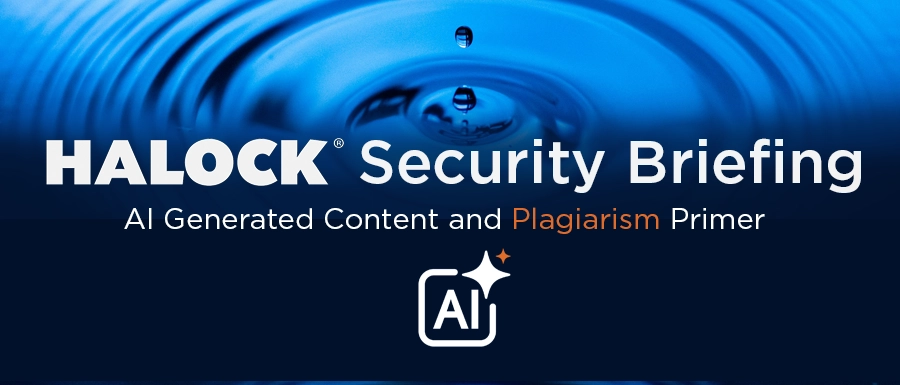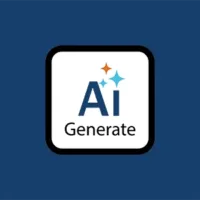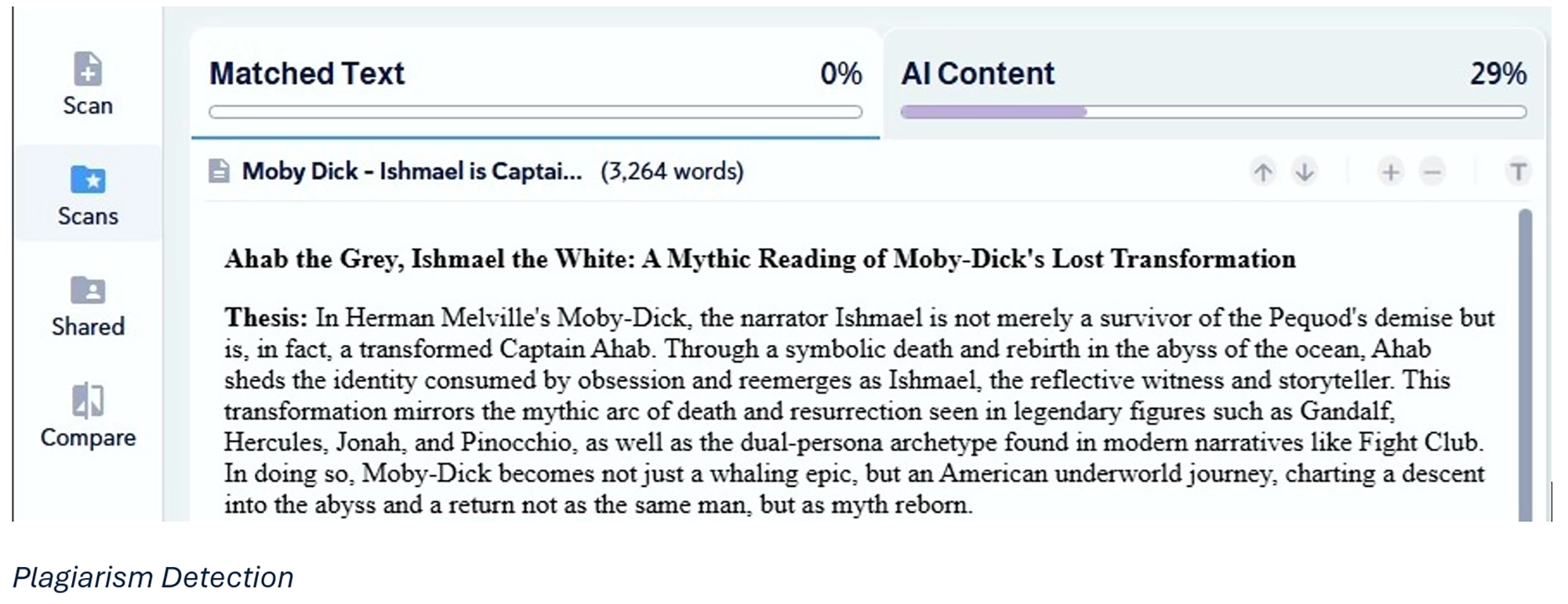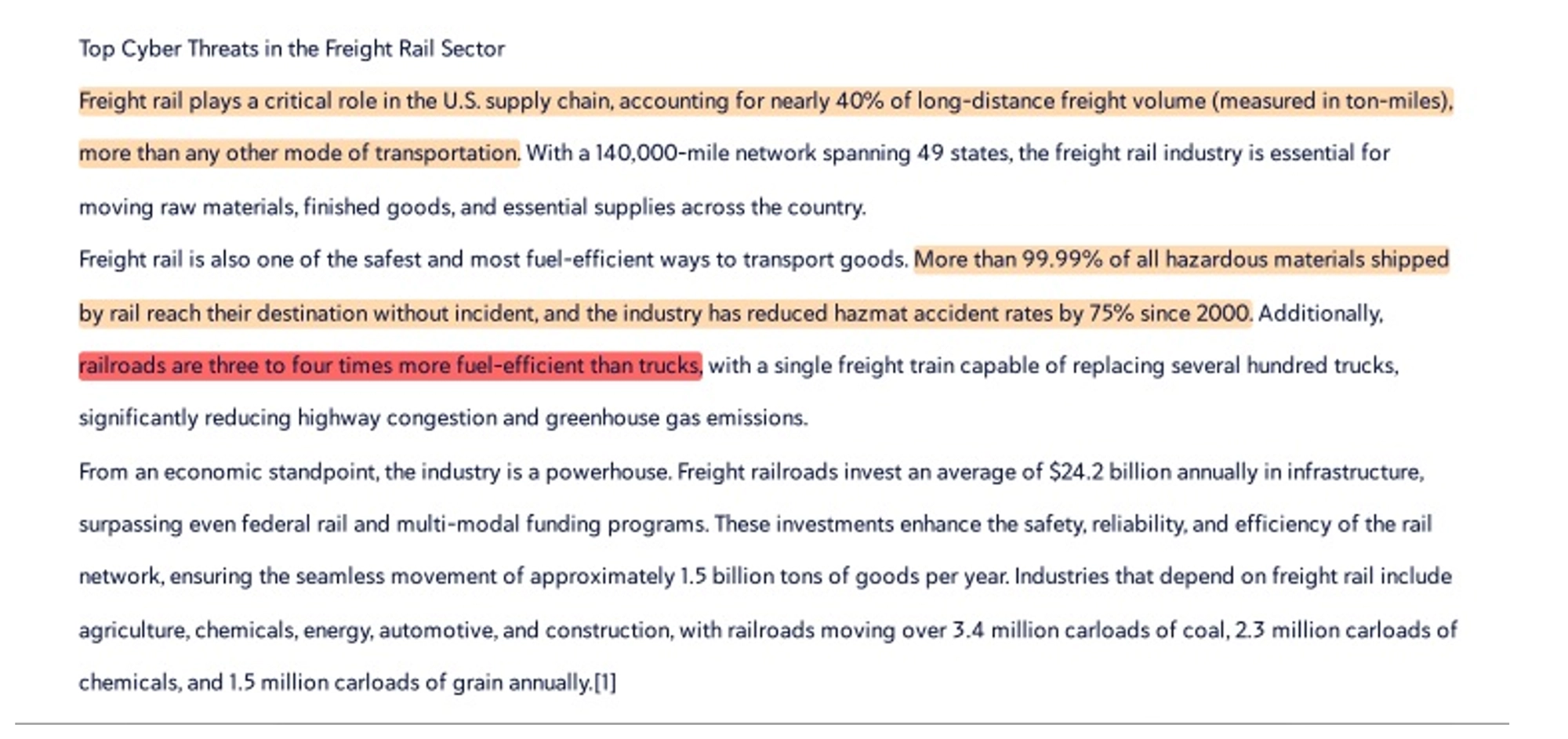If you are in the academic or publishing fields, are a student, or have a child who is a student, then you’ve run into AI-enabled, AI-generated content detection. Historically, the battle was against plagiarism. Publishers, authors, teachers, and students wanted to ensure that the content in papers was original or that proper credit was given through an appropriate citation. With the advances in and availability of generative AI (artificial intelligence), educators and publishers now also have the need, as a matter of academic, journalistic, and artistic integrity, to determine if content was AI or human-generated, or a collaboration between the two.
The detection tools are designed to identify content generated entirely or in part by AI, and content that may not have been adequately cited. Copyleaks, Grammarly, ZeroGPT, and others have evolved quickly, being embraced by companies and academic institutions alike to identify both plagiarism and AI content. This is to help protect intellectual property (IP) and assist with compliance processes and ethical standards. While these detection technologies provide valuable insights, they also generate false positives and duplicate matches, which means all output must be part of a larger strategy that includes human oversight and evaluation.
With experience in hand, and citing that of others, in this paper, we’ll discuss the adoption of AI-enabled, AI-generated content detection tools in the enterprise quality assurance processes for content creation.
To facilitate the discussion, we must acknowledge three types of content: “matched” or plagiarized content, entirely AI-generated content, and Human/AI collaborative content. “Matched” or plagiarized content is material that is copied or closely paraphrased from existing human-authored works without appropriate credit given. Entirely AI-generated content is that which is produced entirely or primarily by AI without human creative input. The knowledge and assembly come from the AI source. Human/AI collaborative content is created in a partnership between one or multiple AI solutions and one or more humans. Commonly, this is when AI is used to brainstorm, refine ideas, or get suggestions on a better way to communicate an idea. While it is difficult to ascertain in any meaningful way the level of AI or human dominance in the collaborative effort, attempts are made with the detection tools. It is important to understand this nuance and AI’s content creation limitations when developing content governance policies and interpreting results from detection tools.
Why Does AI-enabled Content Detection Matter?
AI-enabled content detection attempts to address several challenges posed to industry and academia by plagiarism and AI-generated content. Among them are to maintain academic or professional integrity, protect copyright and intellectual property, enhance compliance with authenticity standards and copyright law, and protect the brand or institution’s reputation. They are used by universities, research institutions, and high schools to verify human work and ensure research practices are ethical. Content creators, publishers, and businesses leverage them to protect their intellectual property from unauthorized use both traditionally and through AI sources. Compliance teams at organizations are using them to measure congruity with copyright law and content authenticity standards. Finally, publishers and other organizations have integrated them into quality assurance processes to keep their content original and plagiarism-free.
Risks and Business Impact of Plagiarism Versus AI-generated Content
Although plagiarism and AI-generated content present usual challenges to businesses and institutions, they also present slightly different risks that organizations are trying to address with AI-detection tools.
Risks and Impact of Plagiarism and Copyright Infringement
Copyright infringement and plagiarism can lead to lawsuits, fines, and settlements impacting a company’s bottom line.[1] Copyright infringement is when an entire work, like a poem or song, is incorporated into another work without permission, even though credit is given. Plagiarism is when a line or the entire poem or song is used, and no credit is given. Accidental plagiarism is a risk with AI-generated content.
Reputational damage and a loss of trust amongst customers and stakeholders may ensue if plagiarized content is published.
Plagiarized content can lead to the dilution of ownership of a creator’s or a company’s intellectual property.[2] This equates to intellectual property theft.
Originality is required by regulatory frameworks in education, publishing, and media. Non-compliance with these regulations can lead to fines.
Risks and Business Impact of AI-generated Content
Some institutions and organizations, for example, the media, legal, and academia, are limited by guidance[3], ban, or prohibit AI-generated content. These compliance and regulatory restrictions could lead to policy violations and revenue loss if contributed content is deemed AI-generated and falls outside the permissible parameters. For example, in May 2024, Medium.com added AI policies that prohibited the publication of any AI-generated content, disclosed or not, in the partner program.[4] Medium.com defined AI-generated content as, “AI-generated writing is writing where the majority of the content has been created by an AI-writing program with little or no edits, improvements, fact-checking, or changes. This does not include AI writing tools such as AI outlining, AI-assisted fact, spelling, or grammar checkers.”[5] Organizations with monetized content that was deemed AI-generated lost that revenue stream.
AI-generated content tends to provide false or inaccurate information, and left unchecked, it can expose companies to reputational damage or legal action. In a recent case, a lawyer in Utah was sanctioned by the Utah Court of Appeals after a filing he made contained a reference to a nonexistent court case.[6] These are misinformation and liability risks.
Content that is completely AI-generated cannot be copyrighted at this time[7], which can lead to questions about IP ownership and challenges in resolving them with IP rights. AI-assisted work, however, can be copyrighted if most of the creative input came from the human side of the equation.[8] Recent legal actions indicate deeper currents at work. Music publishers sued Anthropic[9] alleging copyright infringement based on AI-generated music from complete copies of protected works. Further, well-known authors challenged Meta’s AI model training using their copyrighted material.[10]
As a result, customers and stakeholders are beginning to want clear disclosure when AI is used, and a lack of transparency can harm trust in the relationship.
Comparison Table: Plagiarism Detection vs. AI-Generated Content Detection
This table summarizes the differences between AI-generated content detection and AI-enabled plagiarism detection, providing a quick reference for those implementing content integrity strategies.
How does AI-generated Content Detection Work?
Existing plagiarism and AI-generated content detection use AI-enabled algorithms for the identification of copied, paraphrased, or potentially AI-generated content, and they do it well. Well, enough to add value to the content QA process. It does its work through:
Text Preprocessing – The text is broken down into smaller pieces for analysis.
Semantic Analysis – Paraphrased content is detected by advanced natural language processing (NLP) beyond simple text matching.[11]
Database Comparison – Databases including academic papers, web content, and proprietary sources are scanned for similar content.[12]
AI Pattern Recognition – Subtle forms of plagiarism, including hidden characters, rewritten content, modified structures, and AI-generated patterns, are detected by machine learning algorithms.
AI Content Detection Models – Text generation fingerprinting, probability scoring, and linguistic analysis are part of the models for AI-generated content detection.
Report Generation – Reports are provided by the system, providing plagiarism and AI content scores.
Who Uses It?
Educators and Academic Institutions – Student submissions are reviewed to verify they meet the human-generated content requirements, prevent plagiarism, and maintain academic integrity.
Journalists and Publishers – Verify content originality, prevent plagiarism, and aid in the goal of ethical reporting.
Quality Assurance, Compliance, and Legal Teams – upstream of creation, they verify content originality, validate compliance with internal and external guidelines, laws, and regulations.
Businesses and Corporations – To manage brand reputation and protect intellectual property from being commandeered by AI platforms.
What are Commonly Agreed Upon AI-Content Good Practices?
For the fair and ethical use of AI-generated content detection, teams should follow these commonly agreed-upon good practices.
AI-generated content detection should be used as an indicator, not proof of lack of originality or authorship. Many cases have been cited as having pre-Chat-GPT era content being flagged as 100% AI-generated content. This is primarily due to the structure and subject matter of the content.[13]
When AI-content detection flags content, human reviewers should review and opine on the findings with a secondary review process.
Set thresholds for an acceptable amount of AI-generated content to be allowed, if any, in documents, depending on the purpose. Consider that some styles of content formats are more likely to flag as AI-generated. Structured engineering content in bullets or numbers has a high likelihood of being flagged.
Remember to educate teams that AI-generated content detection is not 100% accurate, and certain types of content will erroneously be flagged as AI-generated.
Educate authors, contributors, and product requestors to avoid writing styles that will be flagged as AI-generated content.
Be transparent about the use of AI and inform all stakeholders that AI is used for detection, but final decisions on policy compliance and remediation requirements involve humans in the process.
How Do Compliance Processes Benefit?
Organizations are using AI-generated content to improve their legal and ethical compliance processes by detecting the unauthorized use of copyrighted materials and AI-generated content before publication, and during academic or legal review processes. Through this process, they can more rapidly and accurately:
Identify Copyright Issues – where the use of copyrighted material without credit or appropriate permission is detected.
Support Regulatory Compliance – monitoring alignment with content authenticity requirements.
Detect Potentially AI-generated Content – to verify content is created by humans when required by policy, guidelines, or regulations.
Prevent Unintentional Plagiarism – providing writers guidance to cite sources and ensure AI-generated or collaborative content does not contain accidental plagiarism.
Screenshots of the results of a Copyleaks.com detection tool are included below to illustrate the operation of the plagiarism and AI-detection components. The first image shows a zero percent result for plagiarism.
And the second image shows AI was used in the creation process, and it is identifying 29% of the text as potentially AI generated. The darker purple, the more confidence the phrase is AI-generated.
Using AI-generated Content for Brands Ethically and Strategically
AI-generated Content is a superpower for brands if they use it both ethically and strategically. Following generally accepted practices can allow companies to embrace AI-driven content creation while at the same time keeping their originality and staying compliant with laws and regulations.
Human oversight when working with AI as a creative assistant for initial drafts, recommending improvements, and assembling outputs assures that content stays on-brand and drives engagement.
Verify AI-generated content is compliant with copyright and IP laws by validating against matched text and images.
While AI-generated content can speed up production, final outputs should be reviewed for alignment with the company’s voice and messaging to maintain brand authenticity.
Disclose AI usage transparently when required. In cases where it is used extensively, brands may consider transparency to maintain trust with the audience. Example phrasing has been included in the Appendix of this document.
AI-generated content should meet platform-specific content policies and search engine requirements for maximum effect and visibility (SEO).
Always use a paid license and a secure AI-detection service. To manage privacy risks, organizations should rely on paid AI-detection tool services rather than free services that may compromise sensitive data.
Implementing AI-Enabled Plagiarism and AI-Generated Content Detection in Quality Assurance (QA) Processes
To effectively integrate AI-powered plagiarism and AI-generated content detection in a QA process:
Define Content Integrity – by establishing clear guidelines on acceptable levels and AI-generated content limitations.
Content Analysis – Leverage paid services like Copyleaks.com, Grammarly, and ZeroGPT to perform scans on documents, articles, and/or code.
Review Similarity or Plagiarism and AI Detection Reports – Assess detected similarities, AI-generated content indicators, and determine whether citations are needed, or content needs to be edited.
Take Corrective Actions – Revise or cite content appropriately to ensure compliance and authenticity. The image below shows that the included citation is misplaced, causing the detection tool to flag the related content as plagiarism. The beige area is a lower confidence match, and the red area is a higher confidence match for copyrighted source material. Use this information to correct the citation. Note that often the tools will indicate multiple matches. Use the one that is your actual source material.
Maintain Records – Keep iterations of the work, and scan logs for any future audits or reviews required.
Conclusion
AI-enabled, AI-generated content and plagiarism detection are important to organizations to help maintain integrity and legal compliance in the modern marketplace. As part of a broad strategy including human oversight and ethical decision-making, the tools provide powerful capabilities to help teams identify potential plagiarism and AI-generated content.
Organizations using them must consider that AI-generated content detection solutions are advisory mechanisms rather than decision makers. False positives exist, and duplicate matching text findings are common, so processes must take these into account. The risks with misinformation and compliance issues highlight the need for a balanced approach with humans making the final call.
At the same time, AI-generated content creation represents new opportunities for businesses and creators alike. Each can streamline content creation, improve productivity, and innovate strategies for communicating their brand image. When used in a responsible way with disclosures as needed, legal adherence, and ethical considerations, AI can be a superpower rather than a liability.
By adopting clear AI-enabled, AI-generated content and plagiarism detection processes, organizations can protect intellectual property, brand credibility, and manage compliance while gaining the benefits of AI in a controlled and transparent manner. The key to success is in the balance between AI and human collaboration in the review process as well as the creation process.
Appendix
Example disclaimer phrasing (created with AI):
This document was created by a human analyst in collaboration with generative AI. The final content was developed, reviewed, and edited by a human editor to ensure accuracy, originality, and adherence to applicable legal standards.
This story was written with the assistance of an AI writing program
Image Sources:
Images created using an AI image creation program.
Images were created by a human in collaboration with generative AI. The final content was developed, reviewed, and edited by a human editor to ensure accuracy, originality, and adherence to applicable legal standards.
[1] Copyright Infringement Penalties
[2] The Impact of Intellectual Property Lawsuits on Retailers: A Business Perspective
[3] Generative AI in Academic Research: Perspectives and Cultural Norms
[4] Company AI Policy Examples and Templates – Who Has Banned ChatGPT
[5] Artificial Intelligence (AI) content policy
[6] Utah lawyer sanctioned for court filing that used ChatGPT and referenced nonexistent court case
[7] Copyright Registration Guidance: Works Containing Material Generated by Artificial Intelligence
[8] Recent Developments in AI, Art & Copyright: Copyright Office Report & New Registrations
[9] Anthropic wins early round in music publishers’ AI copyright case
[10] Authors Challenge Meta’s Use Of Their Books For Training AI
[11] Semantic Analysis: Working and Techniques
[12] What is the difference between the Similarity Score and the AI detection percentage? Are they completely separate, or do they influence one another?
[13] Expert Opinion: Why AI Checkers Are Flagging Human-Written Technical Content (and What To Do About It)







